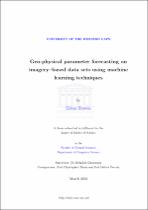| dc.contributor.advisor | Ghaziasgar, Mehrdad | |
| dc.contributor.author | Hussein, Eslam | |
| dc.date.accessioned | 2022-03-24T08:14:06Z | |
| dc.date.available | 2022-03-24T08:14:06Z | |
| dc.date.issued | 2021 | |
| dc.identifier.uri | http://hdl.handle.net/11394/8976 | |
| dc.description | >Magister Scientiae - MSc | en_US |
| dc.description.abstract | This research objectively investigates the e ectiveness of machine learning (ML) tools
towards predicting several geo-physical parameters. This is based on a large number
of studies that have reported high levels of prediction success using ML in the eld.
Therefore, several widely used ML tools coupled with a number of di erent feature sets
are used to predict six geophysical parameters namely rainfall, groundwater, evapora-
tion, humidity, temperature, and wind. The results of the research indicate that: a)
a large number of related studies in the eld are prone to speci c pitfalls that lead to
over-estimated results in favour of ML tools; b) the use of gaussian mixture models as
global features can provide a higher accuracy compared to other local feature sets; c)
ML never outperform simple statistically-based estimators on highly-seasonal parame-
ters, and providing error bars is key to objectively evaluating the relative performance
of the ML tools used; and d) ML tools can be e ective for parameters that are slow-
changing such as groundwater. | en_US |
| dc.language.iso | en | en_US |
| dc.publisher | University of Western Cape | en_US |
| dc.subject | Machine learning | en_US |
| dc.subject | Data | en_US |
| dc.subject | Geo-physical parameters | en_US |
| dc.subject | Rainfall | en_US |
| dc.subject | Groundwater | en_US |
| dc.subject | Evaporation | en_US |
| dc.title | Geo-physical parameter forecasting on imagery{based data sets using machine learning techniques | en_US |
| dc.rights.holder | University of Western Cape | en_US |

